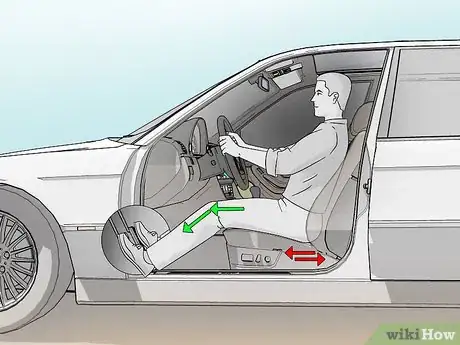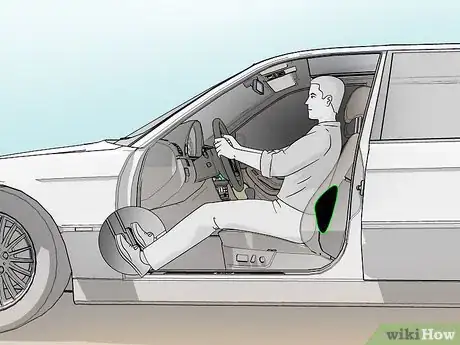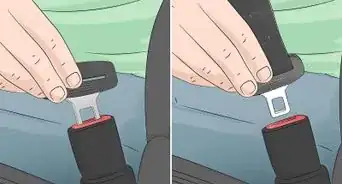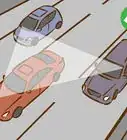This article was co-authored by Ibrahim Onerli and by wikiHow staff writer, Kyle Hall. Ibrahim Onerli is a Driving Instructor and the Manager of Revolution Driving School in New York City. His mission is to make the world a better place by teaching safe driving. Ibrahim trains and manages a team of over eight driving instructors. He specializes in teaching defensive driving and stick shift driving.
wikiHow marks an article as reader-approved once it receives enough positive feedback. In this case, 96% of readers who voted found the article helpful, earning it our reader-approved status.
This article has been viewed 860,437 times.
Driving with your seat adjusted properly will make you more comfortable and safe. There are different ways you can adjust your seat, like moving it toward or away from the steering wheel, changing the incline of the backrest, and moving the headrest up and down. Once your seat is adjusted for comfort and safety, make sure you're sitting in it correctly. Remember to always wear your seat belt!
Things You Should Know
- Slide your seat back so your knees are slightly bent when you press the gas and raise the seat until your hips and knees are level.
- Recline the backrest so it’s positioned at a 100-degree angle and reposition the headrest so your head lays right in the middle.
- Sit with your body all the way back in the seat and make sure your seat belt crosses over your pelvis.
Steps
Using Your Seat Controls
-
1Slide your seat until your knees are slightly bent when you're pressing the gas. Move your seat forward if your legs are completely extended when you press the gas pedal. Move your seat back if your legs are bent too much. Keeping your knees slightly bent while you drive will prevent knee pain.[1]
-
2Sit so there's a gap 2 fingers wide between the back of your knee and the seat. Place 2 fingers between the edge of your seat and the back of your knee. If you can't fit both fingers in the gap, slide your seat back until you're able to.[2]Advertisement
-
3Raise your seat up until your hips are level with your knees. Raise the seat higher if you can’t see clearly out the windshield or windows. Don’t drive with your hips lower than your knees.[3]
- If your car doesn’t have a control to adjust the seat height, sit on a cushion to help keep your hips level with your knees. Make sure you’re not elevated too much or you’ll have to bend down to look out the windshield or windows.
-
4Adjust the backrest so it’s reclined at about a 100 degree angle. Sitting reclined at this angle will decrease pressure on your lower back so you’re more comfortable.[4] If your shoulders lift from the backrest when you turn the steering wheel, your seat is reclined too much. Move the backrest up more if you are hunched forward when driving. When the backrest is in the proper position, you should easily be able to reach the wheel, and your elbows should be slightly bent.[5]
-
5Move the headrest so the back of your head is centered in the middle. If your head is above the headrest when you’re sitting in your seat, move the headrest up. If the back of your head is exposed below the headrest, move the headrest down. Ideally, the top of your head should be level with the top of the headrest.[6]
-
6Adjust the lumbar support so it fits in the curve of your lower back. The lumbar support is the raised portion of the lower backrest. First, adjust the height of the lumbar support so the bottom edge is level with your waistline. Then adjust the depth of the support so it completely fills in the curve of your lower back.[7]
- If your seat doesn’t have lumbar support, roll up a towel and put it in the curve of your back while you’re driving.
- You can also buy an attachable foam support to use in place of lumbar support if your seat doesn’t have it.
EXPERT TIPIbrahim Onerli is a Driving Instructor and the Manager of Revolution Driving School in New York City. His mission is to make the world a better place by teaching safe driving. Ibrahim trains and manages a team of over eight driving instructors. He specializes in teaching defensive driving and stick shift driving.Driving Instructor
 Ibrahim Onerli
Ibrahim Onerli
Driving InstructorTry pressing the brake pedal to ensure it's comfortable. Press the brake all the way down, and pay attention to whether your heel comes up. If it does, your seat needs to be closer. Also, adjust the steering wheel so there's about 10 inches from your chest to the wheel.
Sitting in Your Seat Properly
-
1Sit with your body all the way back in your seat. Your back should be pressed against the backrest, and your bottom should be as far back in your seat as possible. Avoid driving with your body scorched forward; if you can’t reach the pedals or steering wheel, adjust your seat, not your body.[8]
-
2Hold the steering wheel at a “9 and 3” position. Imagine the steering wheel is the face of a clock. Place your left hand where 9 o’clock would be on the clock. Place your right hand where 3 o’clock would be on the clock. Maintaining this grip will give you the most control over the wheel.[9]
- Always drive with both hands on the wheel. Driving with one hand twists your spine, which can lead to back pain.[10]
-
3Keep your left foot on the footrest when you’re not using it. If you’re driving a manual car, only move your left foot when you’re using the clutch. If you’re driving an automatic, you should never move your left foot from the footrest. Keeping your left foot flat on the footrest will help support your back and pelvis while you’re driving.[11]
-
4Wear your seat belt so the strap goes across your pelvis. Don’t wear the strap that stretches across your lap over your stomach. In case of an accident, you want the strap to catch onto your pelvic bone, not your stomach.[12]
Community Q&A
-
QuestionMy husband thinks putting my purse on the floor on the driver's side when I am driving is safe. Is it really safe?
 Community AnswerNo, it isn't safe. There should be nothing placed on the driver's side floor that may move against the pedals or interfere with your foot movement.
Community AnswerNo, it isn't safe. There should be nothing placed on the driver's side floor that may move against the pedals or interfere with your foot movement. -
QuestionHow far should the top of your head be from the roof of the car? Can it be too close?
 Community AnswerAs a rule of thumb, about one fist between your head and the roof. Generally, you should be able to see all of the instruments on the dashboard as well as the road in front of the car.
Community AnswerAs a rule of thumb, about one fist between your head and the roof. Generally, you should be able to see all of the instruments on the dashboard as well as the road in front of the car. -
QuestionShould I have my foot on the clutch when changing gears in a manual vehicle?
 Community AnswerYes, of course; that’s the only way to change the gear selection.
Community AnswerYes, of course; that’s the only way to change the gear selection.
References
- ↑ https://www.driving.co.uk/car-clinic/how-can-i-make-sure-i-have-found-the-perfect-driving-position/
- ↑ http://www.physiomed.co.uk/uploads/guide/file/21/Physiomed_Sitting_Guide_-_Driving_Digital.pdf
- ↑ http://www.physiomed.co.uk/uploads/guide/file/21/Physiomed_Sitting_Guide_-_Driving_Digital.pdf
- ↑ http://www.physiomed.co.uk/uploads/guide/file/21/Physiomed_Sitting_Guide_-_Driving_Digital.pdf
- ↑ https://www.driving.co.uk/car-clinic/how-can-i-make-sure-i-have-found-the-perfect-driving-position/
- ↑ http://www.physiomed.co.uk/uploads/guide/file/21/Physiomed_Sitting_Guide_-_Driving_Digital.pdf
- ↑ http://www.physiomed.co.uk/uploads/guide/file/21/Physiomed_Sitting_Guide_-_Driving_Digital.pdf
- ↑ https://www.driving.co.uk/car-clinic/how-can-i-make-sure-i-have-found-the-perfect-driving-position/
- ↑ http://www.chicagotribune.com/classified/automotive/autoshow/ct-setting-auto-seat-for-safety-comfort-ott-0210-story.html
About This Article
To adjust your seating to the proper position while driving, start by sliding your seat until your knees are slightly bent when you’re pressing the gas pedal. Additionally, make sure there’s a gap 2 fingers wide between the back of your knee and the edge of your seat. Next, raise your seat height to where your hips are level with your knees. Then, adjust the backrest so that it’s reclined at about a 100 degree angle. You should also adjust the headrest so that the top of your head is level with the top of the headrest. For more tips, like how to properly sit in your car seat, read on!







































































